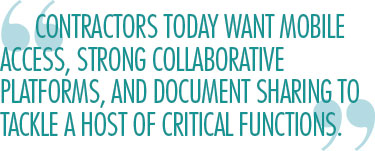Today’s contractor is faced with an interesting dilemma more choices in Project Management solutions than before, but also more complexity in choosing the right solution for their organization. Burger Consulting Group has been monitoring the construction software industry for nearly two decades and has been assisting contractors in making good software decisions for their business. We have observed the number of choices available for project management and collaboration ebb and flow depending largely on the software developers strategy and resources, more so even than the demands of the market which have changed only modestly over the years. Today, contractors want mobile access, strong collaborative platforms, and document sharing, but they also need high-performance platforms for RFIs, submittals, change orders, cost management, issue tracking, and meeting minutes, among many other critical functions.
Cloud-based applications have emerged to fill the needs for collaboration. An earlier generation came and went in the early 2000s with the first .com wave. The ERP vendors, eager to increase seat count (a revenue mechanism) and provide an integrated approach, have finally caught up functionally, although some would argue this point. Many contractors have opted for the integrated approach even if compromising slightly in platform or functionality. Others have felt that this would be a compromise in the wrong direction and decided to go best-in-class for the project managers and sacrifice a little efficiency. Other brave souls have opted to integrate a best-in-class PM solution with the ERP using a third-party middleware solution.

So how should a contractor, a general contractor, or CM to be specific, approach the marketplace when looking for a PM solution? For purposes of this brief article, the author has broken the factors for consideration into two primary groups. First are the larger considerations, you could almost call strategic. From that list you should be able to cull a list of five or six vendor choices to perhaps two or three. From there, the second category can help refine to a single choice. Obviously a checklist alone will not suffice for making the decision, but it can help structure your process to get you to that point confidently. It is very important to involve a small team from your organization in selecting the solution. Getting to the shortlist quickly and efficiently will allow the team to focus on the best candidates and not get confused or distracted by some good looking, but poor fitting choices. Certainly demonstrations, reference calls, and due diligence are all still necessary.
LARGER STRATEGIC CONSIDERATIONS
Integrated v Best-In-Class: By now, most construction companies have migrated to a generation of ERP solutions, at least the construction based ones that offer a PM module. It is likely integrated with all the base functionality and, importantly, allows the PMs to be in a single solution to do most of their PM, cost management, billing, and procurement functions. A company probably should not change ERP solutions just to get PM’s a better integrated PM module. But if there are other reasons to move, like an aging platform, then maybe it is time to consider an ERP with a nearly state-of-the-art PM solution or perhaps integration capabilities to PM products.
Collaboration: This is really one of the larger questions that should be pursued first. If you are going to get your owner, architect, and subs to collaborate on documents and PM functions (e.g., RFIs) and want that capability, an on-premise, hosted PM solution, or module from a PM solution is not likely to suit. By the same token, you should not compromise other elements in favor of a strong collaborative platform if your market is not demanding or expecting to collaborate to a greater extent. But BCG has seen a significant shift here by architects and subs being more open to approach than in years past and many owners are now requiring it.
Cost Management: This is always a contentious issue. Finance likes to have control of the “book of record” for job costing and they need to. So, do you force project managers into the ERP application to do cost management functions like change orders and forecasting or do you move the cost data from Job Cost to a stand-alone PM solution that allows for more flexible reporting and that has robust change order management functions? This is a question deserving its own article.
Functionality/Flexibility: All PM software products offer some level of functionality. Older software solutions often have an advantage of more functionality (not all of it relevant) and being rich and mature, but could be lacking in state-of-the-art technology. Functionality is what gets the job done at the end of the day, but when functionality is lighter, flexibility become critical. Users or IT should be able to add fields, modify or add reports, or develop integrations within the base solution. ■
Part 2 of this article will focus on important secondary factors such as cloud/SaaS deployment, reporting, BIM integration, and other factors.
About the Author: Christian Burger is the president of Burger Consulting Group, an IT consulting firm based in Chicago. Christian has worked within the construction industry for nearly 25 years, originally with FMI before starting his own firm in 1997. Much of his work at the firm is focusing on IT strategy and leadership for BCG clients. Christian is also involved in best practices process work during the implementation phase.
_________________________________________________________________________
Modern Contractor Solutions – May 2016
Did you enjoy this article?
Subscribe to the FREE Digital Edition of Modern Contractor Solutions magazine.

Project Management Software: Part 1 of 2


